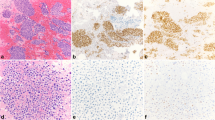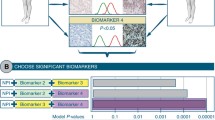Abstract
Purpose
For invasive breast cancer (IBC), high SOX10 expression was reported particularly in TNBC. This raised the possibility that SOX10 may complement other breast markers for determining cancers of breast origin.
Methods
Here, we compared the expression of SOX10 with other breast markers (GATA3, mammaglobin and GCDFP15) and their combined expression in a large cohort of IBC together with nodal metastases. We have also evaluated the expression of GATA3 and SOX10 in a wide spectrum of non-breast carcinomas to assess their value as breast specific markers.
Results
Compared with other markers, SOX10 showed lower overall sensitivity (6.5%), but higher sensitivity in TNBC (31.4%) than other breast markers including GATA3 (29.7% for TNBC). Its expression demonstrated the highest concordance between the paired IBC and nodal metastases (96.4%, κ = 0.663) among all the breast markers. More importantly, SOX10 identified many GATA3-negative TNBC, thus the SOX10/GATA3 combination was the most sensitive marker combination for IBC (86.6%). For non-breast carcinoma, a high SOX10/GATA3 expression rate was found in melanoma (77.9%, predominately expressed SOX10), urothelial carcinoma (82.0%, predominately expressed GATA3) and salivary gland tumors (69.4%). Other carcinomas, including cancers from lungs, showed very low expression for the marker combination.
Conclusions
The data suggested that SOX10/GATA3 combination can be used for differentiating metastases of breast and multiple non-breast origins. However, the differentiation with melanoma and urothelial tumors required more careful histologic examination, thorough clinical information and additional site-specific IHC markers. For salivary gland tumors, the overlapping tumor types with IBC renders the differentiation difficult.

Similar content being viewed by others
References
Luo MH, Huang YH, Ni YB, Tsang JY, Chan SK, Shao MM, Tse GM (2013) Expression of mammaglobin and gross cystic disease fluid protein-15 in breast carcinomas. Hum Pathol 44(7):1241–1250. https://doi.org/10.1016/j.humpath.2012.10.009
Laurent E, Begueret H, Bonhomme B, Veillon R, Thumerel M, Velasco V, Brouste V, Hoppe S, Fournier M, Grellety T, MacGrogan G (2019) SOX10, GATA3, GCDFP15, androgen receptor, and mammaglobin for the differential diagnosis between triple-negative breast cancer and TTF1-negative lung adenocarcinoma. Am J Surg Pathol 43(3):293–302. https://doi.org/10.1097/PAS.0000000000001216
Ni YB, Tsang JYS, Shao MM, Chan SK, Cheung SY, Tong J, To KF, Tse GM (2018) GATA-3 is superior to GCDFP-15 and mammaglobin to identify primary and metastatic breast cancer. Breast Cancer Res Treat 169(1):25–32. https://doi.org/10.1007/s10549-017-4645-2
Shaoxian T, Baohua Y, Xiaoli X, Yufan C, Xiaoyu T, Hongfen L, Rui B, Xiangjie S, Ruohong S, Wentao Y (2017) Characterisation of GATA3 expression in invasive breast cancer: differences in histological subtypes and immunohistochemically defined molecular subtypes. J Clin Pathol 70(11):926–934. https://doi.org/10.1136/jclinpath-2016-204137
Lin F, Liu H (2014) Immunohistochemistry in undifferentiated neoplasm/tumor of uncertain origin. Arch Pathol Lab Med 138(12):1583–1610. https://doi.org/10.5858/arpa.2014-0061-RA
Mollaaghababa R, Pavan WJ (2003) The importance of having your SOX on: role of SOX10 in the development of neural crest-derived melanocytes and glia. Oncogene 22(20):3024–3034. https://doi.org/10.1038/sj.onc.1206442
Chiu K, Ionescu DN, Hayes M (2019) SOX10 expression in mammary invasive ductal carcinomas and benign breast tissue. Virchows Arch. https://doi.org/10.1007/s00428-019-02557-1
Cimino-Mathews A, Subhawong AP, Elwood H, Warzecha HN, Sharma R, Park BH, Taube JM, Illei PB, Argani P (2013) Neural crest transcription factor Sox10 is preferentially expressed in triple-negative and metaplastic breast carcinomas. Hum Pathol 44(6):959–965. https://doi.org/10.1016/j.humpath.2012.09.005
Miettinen M, McCue PA, Sarlomo-Rikala M, Biernat W, Czapiewski P, Kopczynski J, Thompson LD, Lasota J, Wang Z, Fetsch JF (2015) Sox10–a marker for not only schwannian and melanocytic neoplasms but also myoepithelial cell tumors of soft tissue: a systematic analysis of 5134 tumors. Am J Surg Pathol 39(6):826–835. https://doi.org/10.1097/PAS.0000000000000398
Nelson ER, Sharma R, Argani P, Cimino-Mathews A (2017) Utility of Sox10 labeling in metastatic breast carcinomas. Hum Pathol 67:205–210. https://doi.org/10.1016/j.humpath.2017.08.011
Harbhajanka A, Chahar S, Miskimen K, Silverman P, Harris L, Williams N, Varadan V, Gilmore H (2018) Clinicopathological, immunohistochemical and molecular correlation of neural crest transcription factor SOX10 expression in triple-negative breast carcinoma. Hum Pathol 80:163–169. https://doi.org/10.1016/j.humpath.2018.06.007
Tozbikian GH, Zynger DL (2019) A combination of GATA3 and SOX10 is useful for the diagnosis of metastatic triple-negative breast cancer. Hum Pathol 85:221–227. https://doi.org/10.1016/j.humpath.2018.11.005
Lehmann BD, Pietenpol JA (2015) Clinical implications of molecular heterogeneity in triple negative breast cancer. Breast 24(Suppl 2):S36–40. https://doi.org/10.1016/j.breast.2015.07.009
Haupt B, Ro JY, Schwartz MR (2010) Basal-like breast carcinoma: a phenotypically distinct entity. Arch Pathol Lab Med 134(1):130–133. https://doi.org/10.1043/1543-2165-134.1.130
Miettinen M, McCue PA, Sarlomo-Rikala M, Rys J, Czapiewski P, Wazny K, Langfort R, Waloszczyk P, Biernat W, Lasota J, Wang Z (2014) GATA3: a multispecific but potentially useful marker in surgical pathology: a systematic analysis of 2500 epithelial and nonepithelial tumors. Am J Surg Pathol 38(1):13–22. https://doi.org/10.1097/PAS.0b013e3182a0218f
Ni YB, Tsang JY, Shao MM, Chan SK, Tong J, To KF, Tse GM (2014) TTF-1 expression in breast carcinoma: an unusual but real phenomenon. Histopathology 64(4):504–511. https://doi.org/10.1111/his.12287
Magro CM, Crowson AN, Mihm MC (2006) Unusual variants of malignant melanoma. Mod Pathol 19(Suppl 2):S41–70. https://doi.org/10.1038/modpathol.3800516
Foschini MP, Krausz T (2010) Salivary gland-type tumors of the breast: a spectrum of benign and malignant tumors including "triple negative carcinomas" of low malignant potential. Semin Diagn Pathol 27(1):77–90
Alath P, Kapila K, Hussein S, Amanguno H, Hebbar HG, George SS, Francis IM (2014) Parotid gland metastasis of breast cancer diagnosed on fine needle aspiration cytology: case report and review of literature. Cytopathology 25(5):346–348. https://doi.org/10.1111/cyt.12108
Lopez F, Rodrigo JP, Silver CE, Haigentz M Jr, Bishop JA, Strojan P, Hartl DM, Bradley PJ, Mendenhall WM, Suarez C, Takes RP, Hamoir M, Robbins KT, Shaha AR, Werner JA, Rinaldo A, Ferlito A (2016) Cervical lymph node metastases from remote primary tumor sites. Head Neck 38(Suppl 1):E2374–2385. https://doi.org/10.1002/hed.24344
Funding
No funding support was received for this study.
Author information
Authors and Affiliations
Corresponding author
Ethics declarations
Conflicts of interest
All authors have no conflicts of interest.
Ethical approval
All procedures performed in studies involving human participants were in accordance with the ethical standards of the institutional and/or national research committee and with the 1964 Helsinki Declaration and its later amendments or comparable ethical standards. The study was approved, including dispensation from the requirement of patient consent by Joint Chinese University of Hong Kong—New Territories East Cluster clinical research ethics committee (2014.500).
Informed consent
The samples involved in the current study were retrieved from pathology tissue bank after used for diagnosis. All samples were irreversibly anonymized prior to inclusion of the study. Researchers were blinded from patient data during experimental and statistical procedure. Patient confidentiality has been protected and the study involved minimal risk to the subjects, Therefore, the requirement to obtain written consent has been waived.
Additional information
Publisher's Note
Springer Nature remains neutral with regard to jurisdictional claims in published maps and institutional affiliations.
Electronic supplementary material
Below is the link to the electronic supplementary material.
Rights and permissions
About this article
Cite this article
Aphivatanasiri, C., Li, J., Chan, R. et al. Combined SOX10 GATA3 is most sensitive in detecting primary and metastatic breast cancers: a comparative study of breast markers in multiple tumors. Breast Cancer Res Treat 184, 11–21 (2020). https://doi.org/10.1007/s10549-020-05818-9
Received:
Accepted:
Published:
Issue Date:
DOI: https://doi.org/10.1007/s10549-020-05818-9




